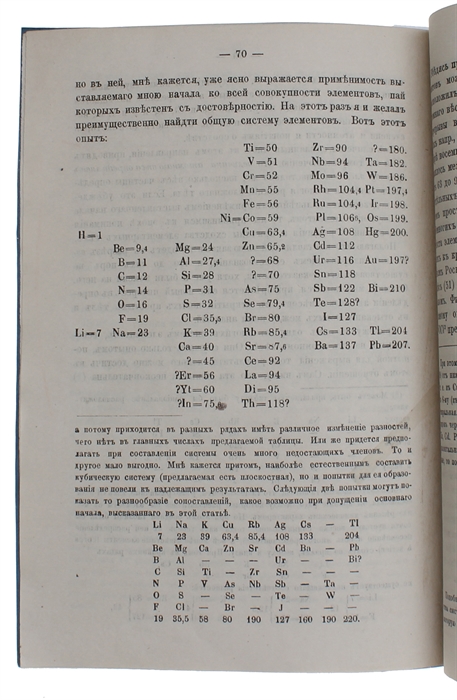THE PERIODIC TABLE OF THE ELEMENTS
[MENDELEEV, D.I.]
Sootnoshenie svoistv s atomnym vesom elementov [i.e. On the Relation of the Properties to the Atomic Weights of the Elements]. In: Zhurnal Russkogo khimicheskogo obshchestva [i.e. Journal of the Russian Chemical Society], vol.1, parts II-III.
St. Petersburg, 1869.
8vo. Extract in contemporary or slightly later blank blue paper wrappers. Wrappers with neat professional restorations from verso, barely noticeable. A very fine and clean copy. Pp. 60-77.
Exceedingly scarce first printing of Mendeleev’s seminal Russian Chemical Society-paper of March 1869, presenting for the first time the periodical table of the elements. “His newly formulated law was announced before the Russian Chemical Society in March 1869 with the statement “elements arranged according to the value of their atomic weights present a clear periodicity of properties.” Mendeleev’s law allowed him to build up a systematic table of all the 70 elements then known.” (Encycl. Britt.) “Early in 1869, Russian chemist Dmitrii Mendeleev was in a predicament many people are familiar with—he was facing a deadline. He had delivered the first volume of his inorganic chemistry textbook to his publisher but was struggling with how to organize the second volume. This struggle would culminate in a remarkable discovery, a system that classified all of the chemical elements. In March 1869, Mendeleev delivered a full paper to the Russian Chemical Society spelling out the most significant aspect of his system, that characteristics of the elements recur at a periodic interval as a function of their atomic weight. This was the first iteration of the periodic law.” (OSU) Mendeleev’s system was not yet perfect when it appeared in 1869, but it would prove to be one of the most fundamental of scientific laws, one that would hold true through new discoveries and against all challenges. Mendeleev not only recognized that what seemed to be a randomness of the elements fitted into a system, he also suggested that the gaps in his system would later be filled with elements yet unknown to the scientific world. The discovery of new elements in the 1870s fulfilled several of Mendeleev’s predictions and brought increased interest to the periodic system, making it an invaluable tool for research. “He had such faith in the validity of the periodic law that he proposed changes to the generally accepted values for the atomic weight of a few elements and predicted the locations within the table of unknown elements together with their properties. At first the periodic system did not raise interest among chemists. However, with the discovery of the predicted elements, notably gallium in 1875, scandium in 1879, and germanium in 1886, it began to win wide acceptance. Gradually the periodic law and table became the framework for a great part of chemical theory. By the time Mendeleev died in 1907, he enjoyed international recognition and had received distinctions and awards from many countries.” (Encycl. Britt.) Horblit 74 [Dibner 48 - citing the German translation of 1891]
Barchas 1412
Order-nr.: 60073


![Sootnoshenie svoistv s atomnym vesom elementov [i.e. On the Relation of the Properties to the Atomic Weights of the Elements]. In: Zhurnal Russkogo khimicheskogo obshchestva [i.e. Journal of the Russian Chemical Society], vol.1, parts II-III.](/images/product/60073b.jpg)
![Sootnoshenie svoistv s atomnym vesom elementov [i.e. On the Relation of the Properties to the Atomic Weights of the Elements]. In: Zhurnal Russkogo khimicheskogo obshchestva [i.e. Journal of the Russian Chemical Society], vol.1, parts II-III.](/images/product/60073c.jpg)
![Sootnoshenie svoistv s atomnym vesom elementov [i.e. On the Relation of the Properties to the Atomic Weights of the Elements]. In: Zhurnal Russkogo khimicheskogo obshchestva [i.e. Journal of the Russian Chemical Society], vol.1, parts II-III.](/images/product/60073d.jpg)